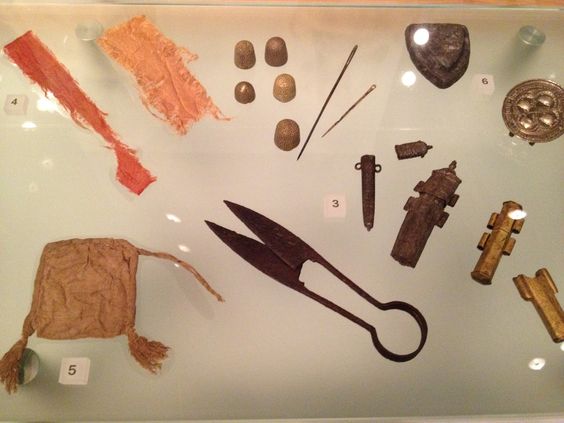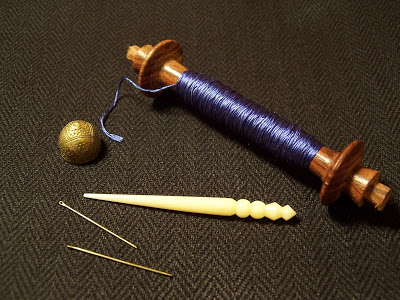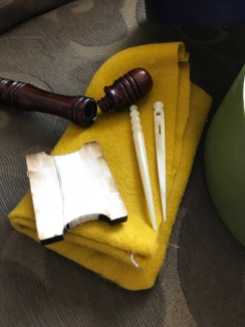So, you want to assemble a sewing kit for your Italian Peninsula persona? This is a guide to doing so with sources to point you in the right direction for your place and time. Remember, many things were similar on the peninsula but each city was its own autonomous region with its own dialect and terms for the following items. It’s up to you to do further research to determine the nuances of your city.

If you were to assemble a modern sewing kit you’d probably think of scissors, needles, sewing pins, thread, and an awl. Let’s see what pictorial evidence of those in period looks like. Larsdatter has an annotated list of sewing kit links which is a great place to start. In the photo below of sewing kit finds from London at the Victoria & Albert Museum you can see scaps of silk fabric, a silk pouch, snips, two needles, needlecases, and thimbles.

Starting with scissors, there are 14th-century snips (shown above from V&A) or 14th-15th-century scissors like these:
For needles, sewing pins, and thimbles there are 15th-century examples:

And there are 14th-century examples (including this thimble from Novgorod):
There is also this bronze needle circa 1350-1480:

You’ll want to put them in a needlecase. The case can be silver, wood, bone, or leather, like this 14th-century one:

I like to wind my thread on spools. You can use flat ones like these 2-4 notched ones, or cylindrical ones like this circa 1320 fresco of women winding silk thread:

The blogger at medievalpurses.blogspot.com put together their kit by purchasing from Gaukler Medieval Wares, Lorifactor of Poland, and Historic Enterprises – all known for making very good historical replicas:

You’d want to put all your sewing supplies in one place. A bentwood box, used across Europe over the past thousand years for storing all manner of things, could be that place. Here are two 15th-century depictions of bentwood boxes holding yarn or thread:
So, your kit could contain all the following that we have historical evidence for:
- Scissors/Snips for trimming threads
- Needles
- A needle case to keep your needles safe
- General sewing pins
- Thimble or thimble ring
- Thread of wool, flax (linen), and silk
- Thread spool or winders to keep your threads neat and tidy
- A cube of beeswax for waxing thread
- Bone stiletto or metal awl for opening eyelets
Historic Enterprises offers a “Deluxe Kit” with the following:

Below are Mary Rose finds that are bit late for our purposes but I love the similarities.

SOURCES
Beaudry, Mary. Findings: The Material Culture of Needlework and Sewing. Yale University. 2006.
Egan, Geoff. Medieval Household Daily Living 1150-1450. Boydell Press. 2010.
http://www.larsdatter.com/sewingkits.htm
London finds from the Thames River at the Victoria & Albert Museum
http://medievalpurses.blogspot.com/2013/01/tools-of-trade.html











